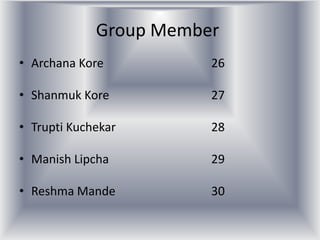
Economic bubble
- 1. Group Member • Archana Kore 26 • Shanmuk Kore 27 • Trupti Kuchekar 28 • Manish Lipcha 29 • Reshma Mande 30
- 3. What is Economic Bubble • Sometimes referred to as a speculative bubble • It could also be described as a trade in products or assets with inflated values.
- 4. Origin of term • “Bubble", in reference to financial crises • Originated in the 1711–1720 British South Sea Bubble
- 5. Impact • Economic bubbles are generally considered to have a negative impact on the economy • Political economist Robert E. Wright argues that bubbles can be identified ex ante with high confidence.
- 6. Effect upon spending • Market participants with overvalued assets tend to spend more because they "feel" richer (the wealth effect) • But When the bubble inevitably bursts, those who hold on to these overvalued assets usually experience a feeling of reduced wealth
- 7. Possible causes • Bubbles occur when prices for a particular item rise far above the item's real value • Some experts think that bubbles are related to inflation and therefore believe that the factors which cause inflation could also be the same factors that cause bubbles to occur.
- 12. 4. Florida Land Boom
- 14. 6. Romanian Property Bubble
- 15. 7. Railway Mania
- 17. 9. South Sea Bubble
- 18. 10. Tulip Mania
- 19. How can economic bubbles be prevented?
- 20. Can Bubbles Benefit the Economy?
